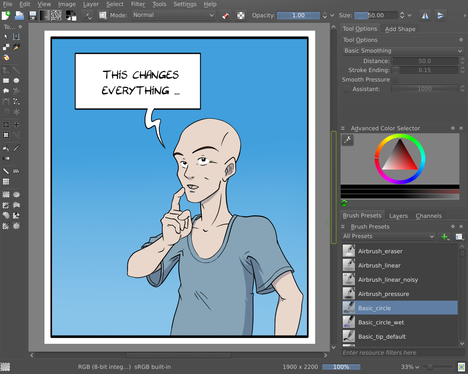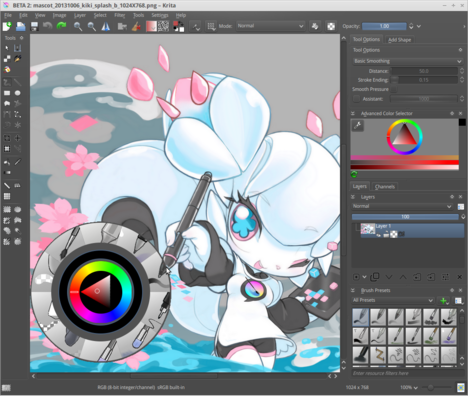Krita: KDE's Powerful Graphics Editor Takes on Photoshop and GIMP
Krita: Listening to the Pros
ByHow a hobby project succeeded with the help of users.
Krita is one of free software’s success stories. In fifteen years, it has gone from a rudimentary paint program to the breakout success in Calligra Suite, which artists are starting to prefer over PhotoShop or GIMP. Recently, Boudewijn Rempt, Krita’s maintainer during much of its progress, took time from his holiday to talk about Krita’s history, where the project is today, and its future direction.
Rempt became interested in free software just out of university, writing a mail and news client and a database application for linguistics. After he wrote a book on PyQt, he looked around for another project to become involved in.
“Coincidentally, I got a cheap Wacom Graphire tablet,” Rempt recalls. “I didn’t really grok GIMP back then, so I did what comes natural: I started a new project, a new painting application. That lasted about half an hour before I realized I hadn’t got a clue how to do a painting application!” Instead, he started looking for existing projects to join.
Rempt settled on Krita. Krita owed its existence to a presentation by Matthias Ettrich, KDE’s founder, at the 1998 Linux Kongress. Ettrich demonstrated creating a Qt interface around GIMP, and when GIMP objected to the idea, KDE decided to create its own graphics editor in May 1999. The fledgling project passed through a variety of names – KImage, KImageShop, and Krayon– but was plagued with trademark or naming issues initiated by opportunistic lawyer. Finally, in 2002, the graphics editor became Krita.
By the time Rempt became involved around 2003, Krita had been rewritten three times, and “was more or less a GUI wrapper around ImageMagick,” as he recalls. “So, I started out with my little tablet and my knowledge of Python and Java to hack a brush tool in this C++ application. I was having so much fun, I sometimes felt working on Krita should be illegal.”
In 2004, Rempt became the maintainer. The project began to attract developers, but for Rempt and many of the contributors, Krita was still a hobby. “We were making software, adding features, doing releases, writing unit tests, doing all the right moves – but we didn’t have any users. We had no idea why, actually.”
Krita’s fortunes declined further when it was ported from Qt3 to Qt4 in 2006. “We lost what users we had,” Rempt says, because “Krita 2.0, 2.1, or 2.2 were plainly unusable. Nothing worked properly. Not even selections, copy, cut, paste, or undo/redo.”
The project found a solution in David Revoy’s Chaos and Evolutions DVD for Blender. “It showed how David used Alchemy, My Paint, and GIMP to create professional art,” Rempt recalls. “He didn’t use Krita, and we were forced to honestly admit that we knew he couldn’t have used Krita! Still, one of us who happened to live nearby went to visit David and sat down for a long afternoon, trying to understand what a real user needed from Krita.”
Around the same time, Krita raised funds so that Lukáš Tvrdý, who had worked on brush engines for his thesis, could work full-time on the project – “fixing stability issues, long-standing bugs, and performance issues” – all informed by the conversations with Revoy. When the 2.3 release came out, Revoy called it “a very nice application,” said Remp, “but not yet suited for daily work for a professional. But an amateur should be pretty happy with Krita, he assured us.”
“That was really the turning point,” Rempt recalls. “We’d bridged the gap between a fun hobby project that’s cool to hack on to something that people could actually use. Right now, at a given Krita development sprint, half the attendees will be artists – users who help us out by showing us how they use Krita and who maintain resources like brush sets of the application icons.”
Rempt continues, “In general, we try to engage artists at the earliest possible stage of a feature design. Usually, a feature request comes in as, “Hey guys, Photoshop and GIMP have this! Can you pretty please put a carbon copy in Krita?” After smoothing down the feathers that inevitably get a little ruffled with a request like this, we check what that feature is supposed to do, how it fits in a workflow. This is a discussion in which developers and artists participate equally. We really try to understand what an artist wants to achieve, and how they use that feature to get there. Often, it’ll turn out that it’s not the easiest way to get there, and then we’ll try and figure out a better way. After all, we’re going for maximum productivity.”
Krita Today
Krita’s habit of listening to users has paid off. The team remains small – four or five regular and about 10 occasional contributors, supported by students in Google’s Summer of Code – but its work continues to be received enthusiastically.
“We’re currently at about a million downloads for Windows, all versions combined,” Rempt says. “Krita on Steam is doing pretty well, though not brilliantly. There are about forty studios who work with us on Krita Studio, the supported version of Krita. [And] I was amazed at the number of times studio people at Siggraph 2014 told me, ‘Oh, yes, Krita! I’ve given that to all our artists – they love it!’”
Support for Krita has been helped by dissatisfaction with rival projects. “Nobody likes Adobe’s Creative Cloud,” Rempt says, “and no one likes the stagnation Photoshop is mired in, and everybody would like to put their artists on Linux. All the other important applications, like Maya, Modo, Nuke, and Mari – they’re all on Linux as well. The thing that’s really missing is a good 2D painting application on Linux, and Krita fits there. We just need more features, better performance, and – probably – Python scripting.”
Officially, Krita is part of Calligra Suite, a descendant project of KOffice. However, according to Rempt, the rest of Calligra is aimed at “a completely different set of users.” Even though Krita releases with Calligra and uses many of the same KDE libraries, increasingly, Krita is becoming “pretty much a standalone project.”
In 2012, the project created the Krita Foundation to manage its affairs, particularly its growing financial ones. This level of organization, Rempt points out, is in stark contrast to the days when Tvrdý was paid through Rempt’s personal bank account. “That’s not a good thing,” Rempt says succinctly. “Especially not when the amount of money grows.”
Another development of recent years is KO GmbH, Rempt’s personal company for Krita support. KO GmbH currently supports a specific version of Krita called Krita Studio, but this arrangement is scheduled to be transferred to the Krita Foundation soon to avoid confusing users.
In fact, the project, Foundation, and KO GMbH all seem to be slowly coming together under the Foundation. Already, the three share the Krita website, and more re-organization seems likely in the future.
“We’re not quite there yet,” Rempt says, “but I am pretty confident that we’ll get there quite soon. My current goal is to fund three/four full-time developers through the Foundation, including myself. We’d need about 25K Euros a month for that, and that should be perfectly achievable.”
Future Directions
Like the rest of Calligra Suite, Krita has recently created a version for portable devices. “People do want to paint on their phones, to my amazement,” Rempt remarks. Additionally, the project is currently porting to the Qt5 framework and considering ports to Android and OS X.
As always, too, Krita is constantly measuring itself against GIMP and Photoshop. Technically, GIMP and Photoshop are raster image editors, whereas Krita is a paint program, but in practice the two categories overlap considerably and appeal to the same user base.
According to Rempt, Krita already has most of the filters that professionals need, but it is picking and choosing other features to implement. For example, “3D printing support is unlikely, but we’d like to have 3D wireframes as painting guides.”
Krita might not have quite arrived where its developers would like to see it, but the progress it has made by consulting users is an object lesson to other projects. Hearing Rempt’s opinions and looking through the project site, it is hard to miss the shared culture of optimism and focus. Depending on your specific needs, Krita may not yet be the world class application its developers aspire to create, but the project leaves the impression that meeting and surpassing those aspirations is only a matter of time.
Subscribe to our Linux Newsletters
Find Linux and Open Source Jobs
Subscribe to our ADMIN Newsletters
Support Our Work
Linux Magazine content is made possible with support from readers like you. Please consider contributing when you’ve found an article to be beneficial.

News
-
Linux Mint 22.3 Now Available with New Tools
Linux Mint 22.3 has been released with a pair of new tools for system admins and some pretty cool new features.
-
New Linux Malware Targets Cloud-Based Linux Installations
VoidLink, a new Linux malware, should be of real concern because of its stealth and customization.
-
Say Goodbye to Middle-Mouse Paste
Both Gnome and Firefox have proposed getting rid of a long-time favorite Linux feature.
-
Manjaro 26.0 Primary Desktop Environments Default to Wayland
If you want to stick with X.Org, you'll be limited to the desktop environments you can choose.
-
Mozilla Plans to AI-ify Firefox
With a new CEO in control, Mozilla is doubling down on a strategy of trust, all the while leaning into AI.
-
Gnome Says No to AI-Generated Extensions
If you're a developer wanting to create a new Gnome extension, you'd best set aside that AI code generator, because the extension team will have none of that.
-
Parrot OS Switches to KDE Plasma Desktop
Yet another distro is making the move to the KDE Plasma desktop.
-
TUXEDO Announces Gemini 17
TUXEDO Computers has released the fourth generation of its Gemini laptop with plenty of updates.
-
Two New Distros Adopt Enlightenment
MX Moksha and AV Linux 25 join ranks with Bodhi Linux and embrace the Enlightenment desktop.
-
Solus Linux 4.8 Removes Python 2
Solus Linux 4.8 has been released with the latest Linux kernel, updated desktops, and a key removal.



